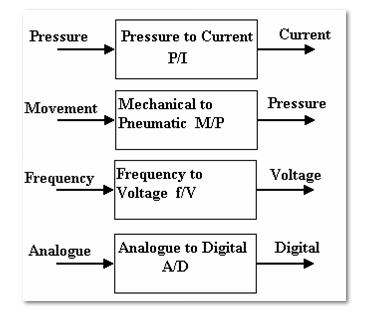Signal converters change a signal from one form to
another. In most cases, we have standard inputs and output ranges.
Most signal converters have two adjustments-zero
and range.
Examples of Signal converters
Nozzle-flapper and differential pressure cells
The nozzle-flapper system is widely used in D.P.
Cells. An example is shown below, that converts differential pressure (e.g. from a differential Pressure flow meter into a standard pneumatic signal). This
is widely used in the control of air operated pipeline valves.
The bellows respond to the differential pressure
and moves the lever. This moves the flapper towards or a way from the nozzle.
The air supply passes through a restrictor and leaks out of the nozzle. The
output pressure hence depends on how close the flapper is to the end of the
nozzle. The range of the instrument is adjusted by moving the pivot and zero
position is adjusted by moving the relative position of the flapper and nozzle.
This system is used in a variety of forms. Instead of bellows, a bourdon tube
might be used and this is operated by an expansion type temperature sensor to
produce a temperature-pneumatic signal converter.
You can also read: Types of Proximity Sensors used in Industrial Control
Current/Pressure conversion
The figures below show typical units for converting
4-20 mA into 0.2-1 bar or 3-15 psi. They contain adjustments for range and
zero. They are widely used for converting the standard pneumatic and electric
signals back and forth. They can also be adjusted to work with non standard
inputs to convert them into a standard form.
 |
| Current to Pressure Converter |
 |
| Pressure to Current Converter |
Electric D.P. Cells
They provide the same functions as the pneumatic
versions but they are given an output of 4-20 mA using electrical pressure
transducers. They are typically used with D.P. Flow meters.
 |
| Differential Pressure Transmitter |
Analogue -Digital Converters
Analogue to digital conversion is a process of turning
an analogue voltage or current into a digital pattern which can read by a
computer and processed, this is done by analogue -digital converters.
Lets look at the Binary Numbers, a number may be represented in digital form by
simply setting a pattern of voltages on a line high or low. It is normal to use
4, 8, 16 or 32 lines. An 8 bit binary pattern is shown in the below figure:
The total pattern is called a word and the one
above is an 8 bit word. The pattern may be stored in an 8 bit register. A
register is a temporary store where the word may be manipulated. The Bit zero
is called the least significant bit (LSB) and the bit with highest value is
called the most significant bit (MSB). Each bit has a value of zero when off
(LOW) or the value shown when on (HIGH). The maximum value for an 8 bit word is
255.
Digital to Analogue Converters
These are devices for converting a binary number
into an analogue voltage. The change in the binary value from zero to a maximum
corresponds with a change in the analogue value from 0 to maximum.
One of the manufacturers of signal converters
is Omega.
Don't miss out on key updates, join our newsletter list here.




